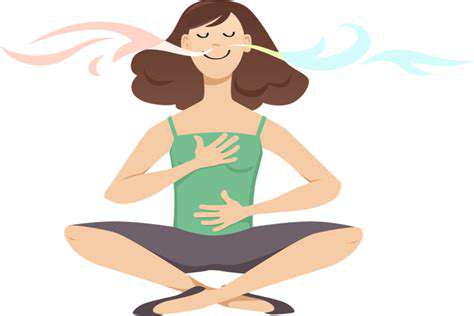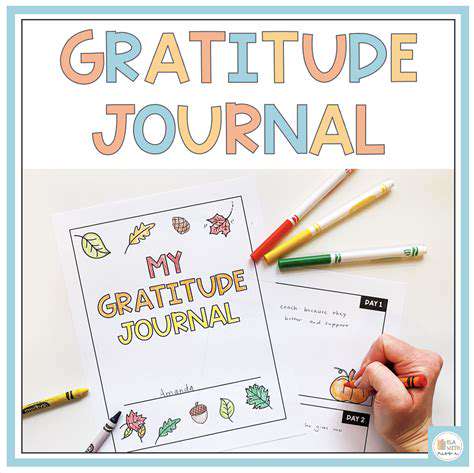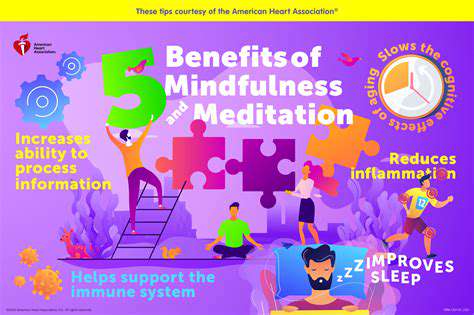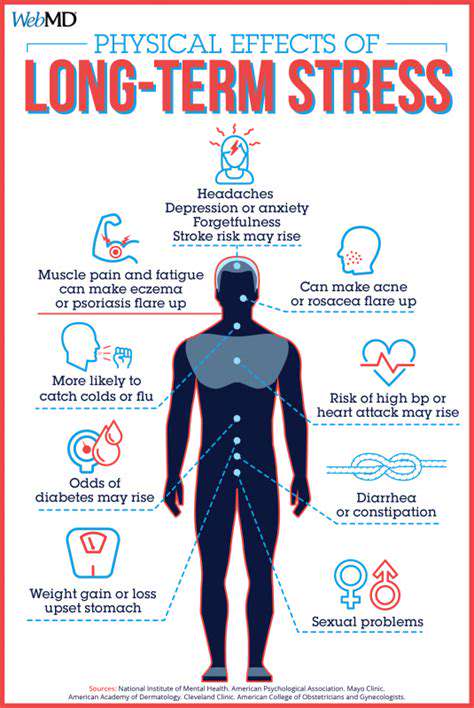Effective Mindfulness Techniques for Everyday Life
Breathing Exercises

Deep Breathing for Relaxation
Deep breathing exercises are a fundamental technique in mindfulness that helps induce a state of relaxation and calmness. By focusing on taking slow, deep breaths, you can significantly lower stress levels and improve your overall sense of well-being.
Your body responds positively to deep breathing, which can lower your heart rate and reduce anxiety. This technique can be practiced anywhere, making it a convenient tool for handling challenging situations throughout your day.
Mindful Breath Counting
Breath counting is a simple yet powerful exercise that encourages mindfulness by focusing your attention solely on your breath. This involves inhaling deeply and then exhaling while silently counting each breath, which helps anchor your thoughts in the present moment.
This practice not only enhances your concentration but also helps you become more aware of your breathing patterns. Over time, it can lead to improved mental clarity and emotional balance.
Guided Breathing Meditations
Many people find guided breathing meditations beneficial for cultivating mindfulness. These sessions often involve an instructor or a recording that leads you through deep breathing techniques and provides soothing background sounds.
Listening to these guided sessions can enhance your ability to focus on your breath and promote a deeper state of relaxation, making it an excellent option for beginners.
Using Breath Awareness in Daily Activities
Integrating breath awareness into everyday tasks can significantly enhance your mindfulness practice. Whether you are walking, eating, or even working, taking a moment to focus on your breathing can transform a mundane activity into a mindful experience.
This approach helps you stay present and fully aware of your surroundings, which can lead to a greater appreciation of life's moments. By connecting your breath with your day-to-day life, you can cultivate a consistent mindfulness practice that enriches your overall well-being.
Body Scan Meditation
Understanding Body Scan Meditation
Body scan meditation is a foundational practice often used in mindfulness and relaxation therapies. This technique encourages practitioners to develop a heightened awareness of their body and its sensations. By focusing on each part of the body, one can cultivate a deeper connection with themselves.
The practice typically begins with a period of deep breathing, allowing the mind to settle before shifting attention to the physical body. Starting from the toes, individuals are guided to notice any tension, discomfort, or sensations present. This gradual, systematic approach enables a comprehensive awareness of how emotions and stress can manifest physically.
As practitioners move through the body, they learn to observe sensations without judgment. This non-reactive approach fosters acceptance and reduces the urge to resist discomfort, ultimately helping to alleviate anxiety and promote relaxation. Body scan meditation can be adapted for individuals at all experience levels, making it an accessible technique for enhancing daily mindfulness.
Regular practice of body scan meditation has been shown to lead to increased mindfulness not just during the practice itself, but also in everyday activities. By integrating this technique into one's routine, individuals can cultivate a greater sense of presence and calm throughout their day.
Techniques for Practicing Body Scan Meditation
To begin practicing body scan meditation, find a quiet and comfortable space where interruptions are minimized. You can either lie down or sit in a relaxed posture, ensuring your body is adequately supported. Close your eyes gently to eliminate distractions and take a few deep breaths to relax your mind.
Once settled, start by focusing on your toes. Notice any sensations—tightness, heaviness, or tingling—without trying to change them. Once you feel connected with your toes, gradually shift your attention to your feet, ankles, and so on, working your way up to the crown of your head.
During the practice, it’s common for thoughts to arise. Instead of engaging with these intrusions, acknowledge them and gently steer your focus back to the body. This reinforces the act of mindfulness by training the mind to return to the present moment.
To deepen this practice, consider incorporating visualization. Imagine each breath flowing into different parts of your body, bringing light and relaxation. By combining focus with imagery, you can enhance the meditative experience and further promote relaxation and body awareness.
Benefits of Body Scan Meditation
Body scan meditation offers numerous benefits that extend beyond the practice itself. Regular engagement in this mindfulness technique can lead to reduced stress levels, as it encourages awareness of the physical manifestations of stress and tension. Understanding how the body reacts to stressors is essential for developing effective coping strategies.
Furthermore, this practice can improve emotional regulation by helping individuals recognize and acknowledge their feelings. Increased awareness allows individuals to respond to emotions more skillfully rather than reacting impulsively, leading to healthier emotional responses in daily interactions.
From a physiological standpoint, body scan meditation can facilitate relaxation responses that promote better sleep quality. By fostering a sense of calm and reducing tension, practitioners often find it easier to drift into sleep, enhancing overall well-being and energy levels throughout the day.
More than just a meditation technique, body scan serves as a valuable tool for fostering self-compassion and understanding. As individuals learn to honor their body and its signals, they cultivate a kinder relationship with themselves, ultimately leading to a more balanced, mindful life.
Mindful Walking
Mindful Walking
Mindful walking is a powerful technique that combines movement with mindfulness practice. It allows individuals to connect with their surroundings and their own bodies as they walk. This practice emphasizes aware observation of each step, encouraging participants to focus on the sensations in their feet, legs, and the rhythm of their breath.
To practice mindful walking, find a quiet space where you can walk uninterrupted. Start by standing still for a moment, feeling the ground beneath your feet. Gradually begin walking at a slow and steady pace, focusing on how each part of your leg and foot moves while engaging all your senses. Notice the sights, sounds, and smells around you, which enrich your experience and anchor your awareness in the present moment.
As distractions arise, acknowledge them without judgment and gently bring your focus back to your walking experience. This method can be refreshing and grounding, providing a simple way to incorporate mindfulness into a daily routine.
Mindfulness in Daily Activities
Incorporating mindfulness into everyday activities can transform routine tasks into meaningful practices. From washing dishes to brushing your teeth, engaging fully in each task encourages a deeper connection to the present moment. When performing these activities, pay attention to the physical sensations, smells, and sounds involved.
For example, while doing the dishes, notice the temperature of the water, the texture of the soap, and the clinking of dishes. Allow yourself to focus entirely on this activity without letting your mind wander to past or future concerns. This practice not only enhances your mindfulness but can also provide a sense of accomplishment and inner peace.
Moreover, practicing mindfulness during daily activities can significantly reduce stress and increase overall well-being. As you learn to be present in various aspects of life, you create a more profound sense of appreciation for the simple moments that make up your day.
Gratitude Journaling

Effective Mindfulness Techniques for Everyday Life
Understanding the Power of Gratitude Journaling
Understanding the Power of Gratitude Journaling
Gratitude journaling is a practice that encourages individuals to reflect on positive experiences and moments of thankfulness. This simple act can significantly shift your mindset, allowing you to focus on the good rather than dwelling on negativity.
By regularly writing down what you are grateful for, you reinforce positive thinking patterns and foster emotional resilience. It creates a tangible reminder of the blessings in your life, helping you to cultivate a more optimistic outlook.
Creating a Daily Routine for Journaling
To reap the full benefits of gratitude journaling, consistency is key. Establish a specific time each day to sit down and write, whether it be in the morning to set a positive tone for the day or in the evening to reflect on the day’s blessings.
This routine not only helps you stay committed but also turns gratitude into a habitual part of your lifestyle. Over time, this practice can lead to enhanced emotional well-being and a greater appreciation for life's small moments.
Choosing the Right Format for Your Journal
Decide on a format that resonates with you—be it a traditional notebook, a digital app, or even voice recordings. The method you choose should feel comfortable and accessible, allowing you to express gratitude freely.
Remember, there are no strict rules; what matters most is that you create a space where you can reflect honestly on your feelings and experiences. Your gratitude journal should be a personal sanctuary of positivity.
Expanding Beyond Simple Lists
While listing things you are grateful for is effective, expanding your entries can deepen the practice. Take time to elaborate on why you are grateful for each item, exploring the emotions and memories associated with them.
This deeper reflection can enhance your understanding of gratitude and its impact, helping to solidify a sense of appreciation in your daily life. By connecting emotionally with your entries, you enrich the journaling experience and its benefits.
Tracking Progress and Reflecting on Change
As you continue your gratitude journaling journey, occasionally review past entries to observe the evolution of your thoughts and sentiments. This practice can highlight how your perspective has shifted over time.
Recognizing this progress can be incredibly powerful, reinforcing the positive impact of gratitude on your life. It also serves as a reminder of the challenges you’ve overcome, solidifying your growth and resilience.
Mindful Eating
Understanding Mindful Eating
Mindful eating is the practice of being fully present while you eat. It involves focusing on the experience of eating and drinking, paying attention to the taste, texture, and aroma of food, as well as your body’s hunger and fullness cues.
By concentrating on the sensory aspects of food, practitioners can cultivate a deeper appreciation for their meals. This heightened awareness helps in recognizing when you're hungry and when you're satisfied, which can prevent overeating.
Additionally, mindful eating encourages you to slow down and savor each bite. This can transform mealtime into a more enjoyable experience, enhancing the flavors and connection to what you consume.
Practicing mindful eating can also foster a healthier relationship with food. Instead of viewing meals as a means to an end, you start to see them as opportunities for nourishment and pleasure.
Ultimately, mindful eating is about cultivating a better awareness of your eating habits and understanding the emotional and physical responses you have to food.
Practical Tips for Mindful Eating
To practice mindful eating, start by eliminating distractions during meals. Turn off the television, put away your phone, and focus solely on the food in front of you. This can help you fully engage with your eating experience.
Another effective strategy is to begin your meal with a moment of gratitude. Take a few seconds to appreciate the food, where it came from, and the effort that went into preparing it. This can create a positive mindset for your meal.
Chewing slowly and thoroughly is another key element of mindful eating. Aim to chew each bite at least 15-20 times before swallowing. This not only aids digestion but also allows you to truly enjoy the flavors and textures of your meal.
Listening to your body is crucial. Before reaching for seconds or dessert, pause and check in with your hunger and satiety levels. Ask yourself if you’re still hungry or if you’re eating out of habit or emotion.
Lastly, consider keeping a food journal where you reflect on your meals. Note how you felt before, during, and after eating. This can provide insights into your eating habits and help you make more mindful choices in the future.

